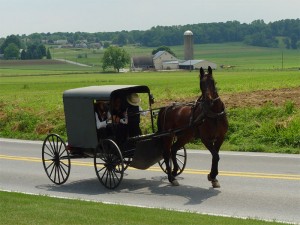 Have you ever witnessed an Amish funeral? Unless you are, in fact, part of that community, you likely have not, and may have never even pondered it. They are modest and simple events, involving members of the family and the local community in preparation, services, and burial. A ritual funeral service is followed by months of ritual “consolation activities” for the immediate family of the person who has died.
Have you ever witnessed an Amish funeral? Unless you are, in fact, part of that community, you likely have not, and may have never even pondered it. They are modest and simple events, involving members of the family and the local community in preparation, services, and burial. A ritual funeral service is followed by months of ritual “consolation activities” for the immediate family of the person who has died.
Even in the event of a very public loss, grief in the community will remain a private thing. Although grief is not ignored or shunned, public displays of it, like we saw with the recent tragedy in Aurora, Colorado, are very rare. The family is usually in charge of caring for the person who has died in their home, dressing them in traditional white funeral garments. Embalmment is allowed in most Amish communities, as long as it is handled by a local professional familiar with the customs.
The family holds three official visitations where friends and family can pay respects to the person who has died. The first is held in the home the day before the funeral service; the second is during the funeral, which also takes place in the home; and the third is at the burial site before the casket is lowered into the ground. Aside from the absence of a funeral home, these events are similar to those common in traditional burials in America.
The official funeral service is where Amish traditions around death differ greatly from traditional funerals seen around America today. The services are very simple, typically held three days after a death in the family’s home or in a barn for larger services. There are no flowers to decorate the casket or the space, but kerosene lamps sometimes serve this purpose. No eulogy is read. Rather than a memorial to the person who has died, the Amish funeral service focuses on praising God.
A funeral to us is a much more important thing than the day of birth because we believe in the hereafter. [Those who have passed] are better off than their survivors.
-Sam Stoltzfus, Amish woodworker
The Amish funeral service is conducted entirely in Pennsylvania Dutch, which is a form of German. Hymns are read, but not sung. Attendees typically wear black, and mourners continue to dress in black garb after the funeral. The immediate family does this for a year-long period of mourning.
The Amish are buried in plain pine caskets crafted within the community, in a local Amish cemetery. Community members generally dig graves by hand, and take turns sitting with the person who has died until the grave is fully dug. Gravestones aren’t ornate, reflecting the Amish belief that no individual is better than another. Some communities don’t even engrave names on the stones. In this case, community elders keep a map of the burial ground with the names of occupants of each plot.
While the Amish traditions certainly call to mind the drab and macabre traditional view on death and dying that contemporary funerary customs are moving away from, some practices are aligned with more progressive modern beliefs. Consider the simplicity of the events, and how this might fit with your beliefs.
Eschewing the ornate decorations on the casket and at the burial site are eco-friendly burial practices, in addition to maintaining the modesty that dictates Amish customs. Home funerals are returning in popularity, with modern consultants to guide families through the planning and preparation of their personalized services. You can also consider the unique focus of the Amish funeral service: praising God and ushering the person who has died into the afterlife. For those who believe in a continuation to life after death, this can be a powerful aspect of the funeral service.
Were you familiar with Amish funeral customs? What aspects might you wish to incorporate in personalized memorial traditions for your own family?

 Simplicity in Amish Funerary Traditions
Simplicity in Amish Funerary Traditions


 “As Tears Go By” by Marianne Faithfull
“As Tears Go By” by Marianne Faithfull
 “The Sea” by John Banville
“The Sea” by John Banville
 Funeral Favors Offer Visitors a Tangible Memento
Funeral Favors Offer Visitors a Tangible Memento















